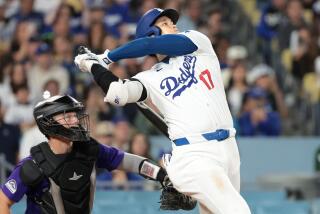Homers Fly, Pitchers Sigh at Coors Field
DENVER — New York Mets’ second baseman Roberto Alomar slammed his bat in disgust as his flyball drifted toward right field, then he broke into a home run trot after the ball bounced off the top of the wall into the stands.
Two weeks earlier, San Diego manager Bruce Bochy calmly talked to reporters after his team blew a 9-7 lead in the ninth inning, then kicked a water cooler and yelled “I hate this place!” as he walked into the coaches’ office.
Welcome to Coors Field, where lazy flyballs turn into homers, ERAs balloon in the high altitude, and five-run leads evaporate in an inning.
“Everybody knows how the ballpark is,” Rockies’ catcher Charles Johnson said. “Even if you don’t play here every day, you know coming in that no lead is safe and that the ball can carry out of here. That’s something you know, period. Everybody in baseball knows that.”
But everybody has a different reaction when they get there.
For hitters, Coors Field is a funhouse, where the expansive outfield and extra carry on the ball can break a slump or start a hot streak.
Since it opened in 1995, Coors Field has been the highest-scoring ballpark in baseball at 18 runs per game, and an average of 252 homers per year have been hit there, also the most in the league.
The Rockies have led the league in batting for a league-record eight straight years (1995-2002) and tied the National League record with the top slugging percentage from 1995-99.
The Rockies also hold the major league record for total bases in a game, combining with Cincinnati for 81 in 1999. They shared another record later that year when nine players on both teams homered in a game with Seattle.
In a two-game series last season, Chicago’s Sammy Sosa hit four homers and set an NL record with 14 RBIs.
“I love hitting here,” said Cincinnati’s Sean Casey, one of the league’s best hitters no matter where he plays. “I wouldn’t mind hitting here all the time.”
But opposing pitchers would rather skip their spot in the rotation than have to pitch at Coors.
Baseballs dry out in the thin, arid air, making them slicker and harder to grip. There also is less air resistance, causing breaking balls to flatten out and changeups to stay up in the zone.
As a result, the Rockies have consistently been among the worst in strikeouts, including a league-low 827 last season, and there have been just 22 shutouts in the history of Coors Field. Colorado’s team ERA has been under 5.00 just twice, with a low of 4.97 in 1995, while the Rockies have battered opposing pitchers for eight or more runs in an inning 11 times.
Just this month, Cincinnati’s Ryan Dempster gave up seven runs in 1 1/3 innings and walked six in the second inning in a Reds’ win, and the Rockies beat the Mets after rallying from a 7-0 deficit with nine runs in two innings.
“It’s kind of like handling a rattlesnake,” said Rockies reliever Todd Jones, in his second season at the hitter-friendly ballpark. “You just have to handle it with care, and if you get bit, you just lick your wounds and get back on the hill the next day.”
But the effects aren’t that easy to shake off.
Because so many runs are scored at Coors -- 12.2 per game this season -- managers are likely to leave their starters in longer and bullpens are stretched thin by the time a series is over.
The Rockies and Braves tied an NL record for pitchers in a game 10 in 12 innings in a game in 2000, and the Rockies share the NL record for most in an inning with five against the Mets in 1997.
“When you leave from here, your pitching is going to be limping,” said Cubs manager Dusty Baker, who has been coming to Coors since it opened, the longest tenure of any opposing manager. “You might beat them, but in the meantime they’re going to beat your pitching staff up. Therefore, you’re not the same for two or three days after leaving here.”
Colorado had its best year at Coors Field in 1995, when it reached the playoffs after a group of bashers known as the “Blake Street Bombers” simply outscored opponents.
It’s been uphill ever since.
The Rockies have continually tinkered with their lineup, trying to combat the effects of Coors with contact hitters, speed, pitching and finally back to power this season.
More to Read
Go beyond the scoreboard
Get the latest on L.A.'s teams in the daily Sports Report newsletter.
You may occasionally receive promotional content from the Los Angeles Times.










